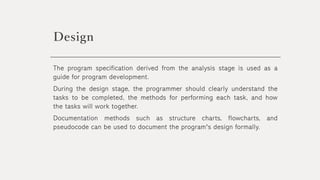Algorithm Design and Problem Solving.pdf
- 1. Algorithm design and problem solving
- 2. PROGRAM DEVELOPMENT LIFE CYCLE(PDLC ) The program development life cycle is divided into five stages: Analysis Design Coding Testing Maintenance
- 3. Analysis • Before solving a problem, it is essential to define and document the problem clearly, known as the "requirements specification" for the program. • The analysis stage involves using tools like abstraction and decomposition to identify the specific requirements for the program. • Abstraction focuses on the essential elements needed for the solution while eliminating unnecessary details and information. • Decomposition involves breaking down complex problems into smaller, more manageable parts that can be solved individually. • Daily tasks can be decomposed into constituent parts for easier understanding and solving.
- 4. Design The program specification derived from the analysis stage is used as a guide for program development. During the design stage, the programmer should clearly understand the tasks to be completed, the methods for performing each task, and how the tasks will work together. Documentation methods such as structure charts, flowcharts, and pseudocode can be used to document the program's design formally.
- 5. Coding and iterative testing • The program or set of programs is developed based on the design. • Each module of the program is written using a suitable programming language. • Testing is conducted to ensure that each module functions correctly. • Iterative testing is performed, which involves conducting modular tests, making code amendments if necessary, and repeating tests until the module meets the required functionality.
- 6. Testing • The completed program or set of programs is executed multiple times using various test data sets. • This testing process ensures that all the tasks within the program work together as specified in the program design. • Running the program with different test data can identify and address potential issues and errors. • The testing phase aims to verify the overall functionality and performance of the program by evaluating its behaviour with various inputs.
- 7. Decomposition This is the act of breaking down a large problem into smaller, clear, manageable and understandable sub-parts. Sub-parts can be divided until they are easily solvable and cannot be broken down any further. An example of decomposition could be getting ready in the morning to go to school Step 1: Wake up Step 2: Brush teeth Step 3: Get breakfast Step 4: Put clothes on Step 5: Make sure the bag and school supplies are ready Step 6: Find transport to school e.g. walk, bus, car, bike, etc
- 8. Example 1: These steps could be further subdivided, for example, “Step 2: Get breakfast” would entail: Step 2.1 Get a bowl Step 2.2 Get cereal Step 2.3 Get milk Step 2.4 Get a spoon Step 2.5 Put cereal in a bowl And so on…
- 9. Methods used to design and construct a solution to a problem ❑ Structure diagrams ❑ Flowcharts ❑ Pseudocode
- 10. Example 2: Structure diagrams Consider the alarm application for a smart phones. It contain three sub-systems – setting the alarm, checking alarm time, sounding alarm
- 11. Flowcharts A flowchart show graphical / diagrammatically the steps required to complete a task the order that they are to be performed. The steps together with the order, are called an algorithm.
- 13. Example 3: Concert ticket Sales Tickets are sold for a concert at $20 each, if 10 tickets are bought then the discount is 10%, if 20 tickets are bought is 20 %. No more than 25 tickets can be bought in a single transaction. This is flowchart an algorithm to calculate the cost of buying a given number of tickets.
- 14. PSEUDOCODE Pseudocode is a simple method of showing an algorithm. It describe what the algorithm does by using English keywords that are very similar to those used in a high-level programming language. Example of pseudocode assignment statements: Cost 10 Cost has the value 10 Price Cost * 2 Price has the value 20 Tax Price * 0.12 Tax has the value 2.4 Selling Price Price + Tax Selling Price has the value 22.4 Gender “M” Gender has value M Choose False Chosen the value False
- 15. Pseudocode for Conditional Statements Two Types of conditional Statement: 1. Condition that can be true or false as: IF ..THEN …ELSE…END IF IF AGE > 18 THEN OUTPUT “ELIGIBLE FOR VOTING ELSE OUTPUT “NOT ELIGIBLE FOR VOTING ENDIF
- 16. CONT.. 2. A choice between several different values, such as: CASE OF…OTHERWISE….ENDCASE CASE OF Grade “A” : OUTPUT “Excellent” “B”: OUTPUT “Good” “C”: OUTPUT “Average” OTHERWISE, OUTPUT “Improvement is needed ENDCASE
- 17. IF..THEN..ELSE..ENDIF For an IF condition the THEN path is followed if the condition is true and the ELSE path is followed if the condition is false. There may or may not be an ELSE path. The end of the statement is shown by ENDIF. There are different ways that an IF condition can be set up: IF (Height >1) OR (Weight > 20) AND (Age < 70) AND (Age > 5) THEN OUTPUT “You can ride” ELSE OUTPUT “Too small, to young or old to ride” ENDIF
- 18. Example: CASE OF…OTHERWISE…ENDCASE CASE OF Choice 1: Answer Num1 + Num2 2: Answer Num1 – Num2 3: Answer Num1 * Num2 4. Answer Num1 / Num2 OTHERWISE, OUTPUT “Please enter a valid choice” ENDCASE
- 19. Pseudocode for iteration Some action performed as part of an algorithm need repeating this is called iteration. Loop structure are used to perform the iteration. • FOR …TO…NEXT ---> A set number of repetitions • REPEAT …UNTIL ---> A repetition, where the number of repeats is not known, that is completed at least once. • WHILE..DO..ENDWHILE ---> A repetition, where the number of repeats is not known, that may never be completed.
- 20. All types of loops A FOR …NEXT loop A WHILE …DO…ENDWHILE loop A REPEAT….UNTIL loop
- 21. THANK YOU Q&A




















